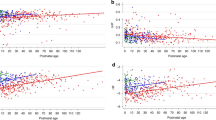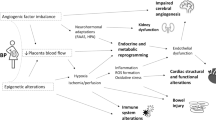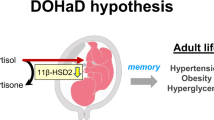Abstract
Hypertension is an important modifiable risk factor for cardiovascular diseases. Its high prevalence, combined with the significant morbidity and mortality associated with secondary complications, make it a major public health concern. Despite decades of research, over 95% of all cases of hypertension remain of unknown etiology, necessitating that treatments target the established symptoms and not the cause. One of the important recent advances in hypertension research is an understanding that hypertension often may have a developmental origin. A substantial body of evidence indicates that exposure to an adverse intrauterine environment during critical periods of development may predispose an individual to develop hypertension later in life. A causative mechanism has yet to be identified, but may include epigenetic modifications, and/or alterations in renal, vascular or autonomic cardiovascular functions. This review will present evidence regarding changes in autonomic activity as a possible causative pathophysiological mechanism underlying the development of programmed hypertension. In man, low birth weight is the best-known risk factor for hypertension of developmental origins, although this is a broad surrogate measure for intrauterine adversity. This review will include clinical studies across the lifespan that have investigated autonomic function in individuals with fetal growth restriction and those born preterm. A determination of whether altered autonomic function is seen in these individuals in early life is imperative, as hypertensive disorders that have their origins in utero, and that can be identified early, will open the door to risk stratification, and the development of new strategies that prevent or specifically target these mechanisms.
This is a preview of subscription content, access via your institution
Access options
Subscribe to this journal
Receive 12 digital issues and online access to articles
$119.00 per year
only $9.92 per issue
Buy this article
- Purchase on Springer Link
- Instant access to full article PDF
Prices may be subject to local taxes which are calculated during checkout
Similar content being viewed by others
References
World Health Organisation. A global brief on hypertension: Silent killer, global public health crisis. 2013. http://apps.who.int/iris/bitstream/10665/79059/1/WHO_DCO_WHD_2013.2_eng.pdf [accessed 17 July 2013] [WebCite Cache ID 6IBqAI2eN]. 2015.
Kirkland EB, Heincelman M, Bishu KG, Schumann SO, Schreiner A, Axon RN, et al. Trends in Healthcare Expenditures Among US Adults With Hypertension: National Estimates, 2003–2014. J Am Heart Assoc. 2018;7:e008731.
Carretero OA, Oparil S. Essential hypertension. Part I: Definition and etiology. Circulation. 2000;101:329–35.
Esler M. The 2009 Carl Ludwig Lecture: pathophysiology of the human sympathetic nervous system in cardiovascular diseases: the transition from mechanisms to medical management. J Appl Physiol. 2010;108:227–37.
Barker DJ, Osmond C. Infant mortality, childhood nutrition, and ischaemic heart disease in England and Wales. Lancet. 1986;327:1077–81.
Woods LL, Weeks DA, Rasch R. Programming of adult blood pressure by maternal protein restriction: role of nephrogenesis. Kidney Int. 2004;65:1339–48.
Dasinger JH, Davis GK, Newsome AD, Alexander BT. Developmental programming of hypertension: physiological mechanisms. Hypertension. 2016;68:826–31.
Esler M. The sympathetic nervous system through the ages: from Thomas Willis to resistant hypertension. Exp Physiol. 2011;96:611–22.
Lambert E, Straznicky N, Schlaich M, Esler M, Dawood T, Hotchkin E, et al. Differing pattern of sympathoexcitation in normal-weight and obesity-related hypertension. Hypertension. 2007;50:862–8.
Menuet C, Le S, Dempsey B, Connelly AA, Kamar JL, Jancovski N, et al. Excessive respiratory modulation of blood pressure triggers hypertension. Cell Metab. 2017;25:739–48.
Anderson EA, Sinkey C, Lawton W, Mark A. Elevated sympathetic nerve activity in borderline hypertensive humans. Evidence from direct intraneural recordings. Hypertension. 1989;14:177–83.
Grassi G. Role of the sympathetic nervous system in human hypertension. J Hypertens. 1998;16:1979–87.
Esler M. The sympathetic system and hypertension. Am J Hypertens. 2000;13(S4):99S–105S.
Palatini P, Julius S. The role of cardiac autonomic function in hypertension and cardiovascular disease. Curr Hypertens Rep. 2009;11:199–205.
Lopes H, Silva H, Consolim-Colombo F, Barreto Filho J, Riccio G, Giorgi D, et al. Autonomic abnormalities demonstrable in young normotensive subjects who are children of hypertensive parents. Braz J Med Biol Res. 2000;33:51–4.
Neumann SA, Jennings JR, Muldoon MF, Manuck SB. White-coat hypertension and autonomic nervous system dysregulation. Am J Hypertens. 2005;18:584–8.
Julius S, Valentini M, Palatini P. Overweight Hypertension: a 2-way street? Hypertension. 2000;35:807–13.
Grassi G. Assessment of sympathetic cardiovascular drive in human hypertension achievements and perspectives. Hypertension. 2009;54:690–7.
Grassi G. Sympathetic neural activity in hypertension and related diseases. Am J Hypertens. 2010;23:1052–60.
Corrao G, Parodi A, Nicotra F, Zambon A, Merlino L, Cesana G, et al. Better compliance to antihypertensive medications reduces cardiovascular risk. J Hypertens. 2011;29:610–8.
Myers MG, Olson DP. Central nervous system control of metabolism. Nature. 2012;491:357–63.
Wulsin LR, Horn PS, Perry JL, Massaro JM, D’Agostino RB. Autonomic imbalance as a predictor of metabolic risks, cardiovascular disease, diabetes, and mortality. J Clin Endocrinol Metab. 2015;100:2443–8.
Gerritsen J, Dekker JM, TenVoorde BJ, Kostense PJ, Heine RJ, Bouter LM, et al. Impaired autonomic function is associated with increased mortality, especially in subjects with diabetes, hypertension, or a history of cardiovascular disease the Hoorn study. Diabetes Care. 2001;24:1793–8.
Palatini P, Dorigatti F, Zaetta V, Mormino P, Mazzer A, Bortolazzi A, et al. Heart rate as a predictor of development of sustained hypertension in subjects screened for stage 1 hypertension: the HARVEST Study. J Hypertens. 2006;24:1873–80.
Judy W, Watanabe A, Henry D, Besch H, Murphy W, Hockel G. Sympathetic nerve activity: role in regulation of blood pressure in the spontaenously hypertensive rat. Circ Res. 1976;38:21–9.
Huxley RR, Shiell AW, Law CM. The role of size at birth and postnatal catch‐up growth in determining systolic blood pressure: a systematic review of the literature. J Hypertens. 2000;18:815–31.
Barker DJP, Osmond C, Golding J, Kuh D, Wadsworth MEJ. Growth in utero, blood pressure in childhood and adult life, and mortality from cardiovascular disease. BMJ: Br Med J. 1989;298:564–7.
Skilton MR, Viikari JS, Juonala M, Laitinen T, Lehtimäki T, Taittonen L, et al. Fetal growth and preterm birth influence cardiovascular risk factors and arterial health in young adults the cardiovascular risk in young Finns study. Arterioscler Thromb Vasc Biol. 2011;31:2975–81.
Crispi F, Bijnens B, Figueras F, Bartrons J, Eixarch E, Le Noble F, et al. Fetal growth restriction results in remodeled and less efficient hearts in children. Circulation. 2010;121:2427–36.
Galland BC, Taylor BJ, Bolton DP, Sayers RM. Heart rate variability and cardiac reflexes in small for gestational age infants. J Appl Physiol. 2006;100:933–9.
van Deutekom AW, Chinapaw MJM, Gademan MGJ, Twisk JWR, Gemke R, Vrijkotte TGM. The association of birth weight and infant growth with childhood autonomic nervous system activity and its mediating effects on energy-balance-related behaviours-the ABCD study. Int J Epidemiol. 2016;45:1079–90.
IJzerman RG, Stehouwer CD, de Geus EJ, van Weissenbruch MM, Delemarre-van de Waal HA, Boomsma DI. Low birth weight is associated with increased sympathetic activity dependence on genetic factors. Circulation. 2003;108:566–71.
Boguszewski MC, Johannsson G, Fortes LC, Sverrisdóttir YB. Low birth size and final height predict high sympathetic nerve activity in adulthood. J Hypertens. 2004;22:1157–63.
Gennser G, Rymark P, Isberg PE. Low birth weight and risk of high blood pressure in adulthood. BMJ. 1988;296:1498–500.
Weitz G, Deckert P, Heindl S, Struck J, Perras B, Dodt C. Evidence for lower sympathetic nerve activity in young adults with low birth weight. J Hypertens. 2003;21:943–50.
Scherrer U, Randin D, Tappy L, Vollenweider P, Jéquier E, Nicod P. Body fat and sympathetic nerve activity in healthy subjects. Circulation. 1994;89:2634–40.
Aziz W, Schlindwein FS, Wailoo M, Biala T, Rocha FC. Heart rate variability analysis of normal and growth restricted children. Clin Auton Res. 2012;22:91–7.
Rakow A, Katz-Salamon M, Ericson M, Edner A, Vanpée M,Kth, et al. Decreased heart rate variability in children born with low birth weight. Pediatr Res. 2013;74:339.
Schroeder EB, Liao D, Chambless LE, Prineas RJ, Evans GW, Heiss G. Hypertension, Blood Pressure, and Heart Rate Variability: The Atherosclerosis Risk in Communities (ARIC) Study. Hypertens: J Am Heart Assoc. 2003;42:1106–11.
Dissanayake HU, McMullan RL, Gordon A, Caterson ID, Celermajer DS, Phang M, et al. Noninvasive assessment of autonomic function in human neonates born at the extremes of fetal growth spectrum. Physiol Rep. 2018;6:e13682-n/a.
Patural H, Barthelemy JC, Pichot V, Mazzocchi C, Teyssier G, Damon G, et al. Birth prematurity determines prolonged autonomic nervous system immaturity. Clin Auton Res. 2004;14:391–5.
Cohen E, Wong FY, Wallace EM, Mockler JC, Odoi A, Hollis S, et al. Fetal-growth-restricted preterm infants display compromised autonomic cardiovascular control on the first postnatal day but not during infancy. Pediatr Res. 2017;82:474–82.
Mathewson KJ, Van Lieshout RJ, Saigal S, Boyle MH, Schmidt LA. Reduced respiratory sinus arrhythmia in adults born at extremely low birth weight: evidence of premature parasympathetic decline? Int J Psychophysiol. 2014;93:198–203.
Yiallourou SR, Witcombe NB, Sands SA, Walker AM, Horne RSC. The development of autonomic cardiovascular control is altered by preterm birth. Early Hum Dev. 2013;89:145–52.
Andriessen P, Oetomo SB, Peters C, Vermeulen B, Pieter FFW, Blanco CE. Baroreceptor reflex sensitivity in human neonates: the effect of postmenstrual age. J Physiol. 2005;568:333–41.
Witcombe NB, Yiallourou SR, Sands SA, Walker AM, Horne RSC. Preterm birth alters the maturation of baroreflex sensitivity in sleeping infants. Pediatrics. 2012;129:e89–96.
Cohen G, Vella S, Jeffery H, Lagercrantz H, Katz-Salamon M. Cardiovascular stress hyperreactivity in babies of smokers and in babies born preterm. Circulation. 2008;118:1848–53.
Van Reempts PJ, Wouters A, De Cock W, Van Acker KJ. Stress responses to tilting and odor stimulus in preterm neonates after intrauterine conditions associated with chronic stress. Physiol Behav. 1997;61:419–24.
Yiallourou SR, Wallace EM, Whatley C, Odoi A, Hollis S, Weichard AJ, et al. Sleep: a window into autonomic control in children born preterm and growth restricted. SLEEP. 2017;40:zsx048.
He X, Zhao M, Bi X, Sun L, Yu X, Zhao M, et al. Novel strategies and underlying protective mechanisms of modulation of vagal activity in cardiovascular diseases: vagal modulation and cardiovascular diseases. Br J Pharmacol. 2015;172:5489–500.
Longin E, Gerstner T, Schaible T, Lenz T, König S. Maturation of the autonomic nervous system: differences in heart rate variability in premature vs. term infants. J Perinat Med. 2006;34:303–8.
Woods LL, Weeks DA. Naturally occurring intrauterine growth retardation and adult blood pressure in rats. Pediatr Res. 2004;56:763–7.
Nuyt AM. Mechanisms underlying developmental programming of elevated blood pressure and vascular dysfunction: evidence from human studies and experimental animal models. Clin Sci. 2008;114:1–17.
Alexander BT, Hendon AE, Ferril G, Dwyer TM. Renal denervation abolishes hypertension in low-birth-weight offspring from pregnant rats with reduced uterine perfusion. Hypertension. 2005;45:754–8.
de Rooij SR, Jones A, Phillips DI, Osmond C, Karemaker JM, Roseboom TJ, et al. Prenatal undernutrition and autonomic function in adulthood. Psychosom Med. 2016;78:991–7.
Juonala M, Cheung MMH, Sabin MA, Burgner D, Skilton MR, Kähönen M, et al. Effect of birth weight on life-course blood pressure levels among children born premature: the Cardiovascular Risk in Young Finns Study. J Hypertens. 2015;33:1542–8.
Mann SJ. Neurogenic hypertension: pathophysiology, diagnosis and management. Clin Auton Res. 2018;28:363–74.
Linz D, Hohl M, Elliott AD, Lau DH, Mahfoud F, Esler MD, et al. Modulation of renal sympathetic innervation: recent insights beyond blood pressure control. Clin Auton Res. 2018;28:375–84.
Acknowledgements
HUD was supported by an Australian Postgraduate Award (SC0042). MRS was supported by a National Heart Foundation of Australia Future Leader Fellowship (100419).
Author information
Authors and Affiliations
Corresponding author
Ethics declarations
Conflict of interest
The authors declare that they have no conflict of interest.
Rights and permissions
About this article
Cite this article
Dissanayake, H.U., Skilton, M.R. & Polson, J.W. Autonomic dysfunction in programmed hypertension. J Hum Hypertens 33, 267–276 (2019). https://doi.org/10.1038/s41371-018-0142-2
Received:
Revised:
Accepted:
Published:
Issue Date:
DOI: https://doi.org/10.1038/s41371-018-0142-2
This article is cited by
-
Hypertension in connective tissue disease
Journal of Human Hypertension (2022)
-
In utero exposure to ultrafine particles promotes placental stress-induced programming of renin-angiotensin system-related elements in the offspring results in altered blood pressure in adult mice
Particle and Fibre Toxicology (2019)



